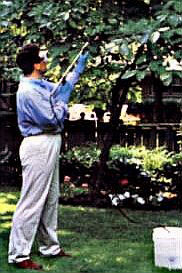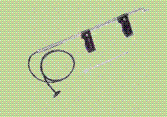SPRAYER CALIBRATION (Trombone bucket sprayer)
 Trombone bucket sprayers have a sprayer wand made up of two pieces. The front piece slides back and forth on the other, much like the slide on a trombone. This movement creates a suction that pulls the mixture out of the bucket through a small hose clipped to the side. The opposite end of the hose is attached to the sprayer.
Trombone bucket sprayers have a sprayer wand made up of two pieces. The front piece slides back and forth on the other, much like the slide on a trombone. This movement creates a suction that pulls the mixture out of the bucket through a small hose clipped to the side. The opposite end of the hose is attached to the sprayer.
Trombone sprayers are useful in treating tall trees that cannot be covered by small compressed air sprayers and hose-end equipment. They are particularly useful for spraying fruit trees.
Like the siphoning device, the trombone sprayer requires a bucket; but there are some major differences. The bucket is not stationary and is carried to the job. There is no attachment to a faucet, nor is a garden hose used to deliver the product.
When using a trombone sprayer, you mix the pesticide product at the label rate, in the bucket; a ratio of 1:1 is used rather than the 16:1 ratio used for the siphoning device.
GOOD NEWS About Trombone Sprayers
- Trombone sprayers can be used to treat tall trees. Fully primed, a trombone sprayer can reach trees as tall as 20 feet.
- Their range of treatment is unlimited. The sprayer is not tethered to a garden hose and does not have to be used in proximity to a water faucet.
- Contamination possibilities are minimal. A garden hose is not used to deliver the product.
- Trombone sprayers are easy to operate. Equipment is self-contained, portable, and relatively easy to maintain; and it requires minimal storage space.
- They are easy to monitor. The level of the bucket mixture is observable while spraying
BAD NEWS About Trombone Sprayers
-

Trombone sprayer
Trombone sprayers are expensive. A quality trombone sprayer costs $40–$60.
- They are somewhat inconvenient. Larger jobs require the user to stop and refill the bucket several times.
- They are awkward. The pesticide applicator has to lift and carry the bucket as the job progresses, and it is very heavy when full.
- Drift can be a factor. Movement of the spray off-target, due to a breeze or wind, can be a problem when spraying tall trees at high pressures.
HOW DO I CALIBRATE A TROMBONE BUCKET SPARAYER? (For spraying plants)
Calibration Steps |
Sample Problem |
| 1. Select a tree to spray.
Fill a 5-gallon bucket with plain water and carry it to the tree. Do not add pesticides at this time. Clip the trombone sprayer hose to your bucket and adjust the nozzle for the desired spray pattern. Spray the entire tree, making sure to completely cover all of the branches and leaves (both sides) and the trunk. Spray to the point that the liquid is just about ready to run or drip off the tree. Note how much liquid remains in the bucket, and subtract it from the 5-gallon capacity to determine how much was used. Repeat this process for the remaining two trees. |
4.75 gal remain
5 gal – 4.75 gal = 0.25 gal 0.25 gal = 1 qt Tree number 1 = 1 qt Tree number 2 = 3 qt Tree number 3 = 8 qt (2 gal) |
| 2. Compute the amount of water required for the job. | 1 qt + 3 qt + 8 qt = 12 qt
12 qt = 3 gallons |
| 3. Compute the amount of pesticide product required for the job. | 5 Tsp / gal x 3 gal = 15 Tsp |
Compiled by Wayne Buhler
